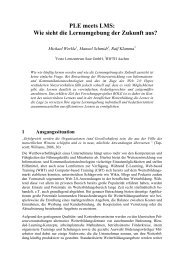Customized PLE implementations for test-bed scenario ... - ROLE
Customized PLE implementations for test-bed scenario ... - ROLE
Customized PLE implementations for test-bed scenario ... - ROLE
You also want an ePaper? Increase the reach of your titles
YUMPU automatically turns print PDFs into web optimized ePapers that Google loves.
structured course with pre-defined materials. Guidance within the learning plat<strong>for</strong>m is<br />
restricted to the pre-given courses, while teachers point to helpful resources and tools.<br />
Personalised learning experiences are mainly realised by the teachers who offer<br />
materials beyond the course content and recommend next instructions, background<br />
literature or other resources (e.g. cultural artefacts like music, helpful tools <strong>for</strong><br />
mathematics, etc). Additionally, learner monitoring is done on a technical level (log files<br />
of school LMS and <strong>PLE</strong> plat<strong>for</strong>m) and by teachers (feedback in class and through<br />
homework). Reflection of learning is mainly supported by quizzes <strong>for</strong> self-assessment.<br />
Collaborative learning is considered to be beneficial, as learners get support from peers.<br />
Thus, teachers try to foster collaboration but face different problematic issues (varying<br />
levels of social competences and skills of students, traditional teacher-centred setting).<br />
In the SJTU <strong>test</strong>-<strong>bed</strong> learners as well as learning outcomes are assessed by teachers<br />
and through exams (multiple-choice quizzes and free text answers), whereby the<br />
learning plat<strong>for</strong>m is not used <strong>for</strong> this purpose. Course-related skills and competences<br />
are assessed by teachers manually and rather in<strong>for</strong>mally while competences beyond<br />
the course domain are not considered at all. A learner profile is not given in this <strong>test</strong><strong>bed</strong>.<br />
Learning is primarily planned by the administration of the university and the<br />
teachers. The learning outcomes (goals) of the courses are defined by the teachers in a<br />
<strong>for</strong>mal and explicit way. Restrictions of <strong>ROLE</strong> concepts in the <strong>test</strong>-<strong>bed</strong> are given through<br />
the size of classes, a lack of tools and time, differences in the skills of learners, and a<br />
lack of self-directedness of students. Training materials comprise slides, written<br />
homework artefacts, course books, video files, and lecture streams. Materials are not<br />
customizable, not based on a content model, or being analysed through ICT.<br />
With respect to the community perspective, learning is restricted to the organisation,<br />
the university, and to the context of <strong>for</strong>mal education, i.e. learners are supposed to get<br />
an academic degree. Students are learning on their own and in groups but they are also<br />
motivated to collaborate, e.g. by being encouraged to solve exercises together. In the<br />
<strong>test</strong>-<strong>bed</strong>, new media technology is applied. Precisely, in some courses mash-up<br />
technology is used. Teachers suggest appropriate learning tools in the <strong>for</strong>m of pre-built<br />
<strong>PLE</strong>s while there is no focus on recommending peers or artefacts within the learning<br />
activities. The SJTU <strong>test</strong>-<strong>bed</strong> utilises two plat<strong>for</strong>ms, a learning management system<br />
(LMS) provided by the university and a <strong>PLE</strong> solution called Liferay and introduced by<br />
teachers (cf. appendix B.2). Various Web 2.0 plat<strong>for</strong>ms are blocked by the Chinese<br />
government; other applications are not accessible at the learners’ workplaces.<br />
Learner interactions are captured in the <strong>for</strong>m of log files within the two plat<strong>for</strong>ms and<br />
CAM data within Liferay as given by the OpenApp mechanism (see also <strong>ROLE</strong><br />
deliverable D3.4: ‘Prototypical <strong>implementations</strong>’). Thereby, OpenApp provides<br />
in<strong>for</strong>mation on user interactions through events, i.e. the activity a learner is involved in,<br />
the tool (gadget) that is used, and some details on the event (type, time, etc). This data<br />
is used <strong>for</strong> analysing simple aspects, like the number of students using the plat<strong>for</strong>ms,<br />
and <strong>for</strong> novel approaches like <strong>PLE</strong> recommendations, as explained later. From the<br />
organisational perspective, it is possible to collect and analyse user data, to install any<br />
kind of software, to open up the environment, and to store data externally (e.g. in Web<br />
Page 28 of 102



